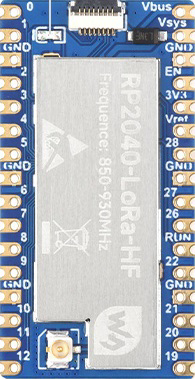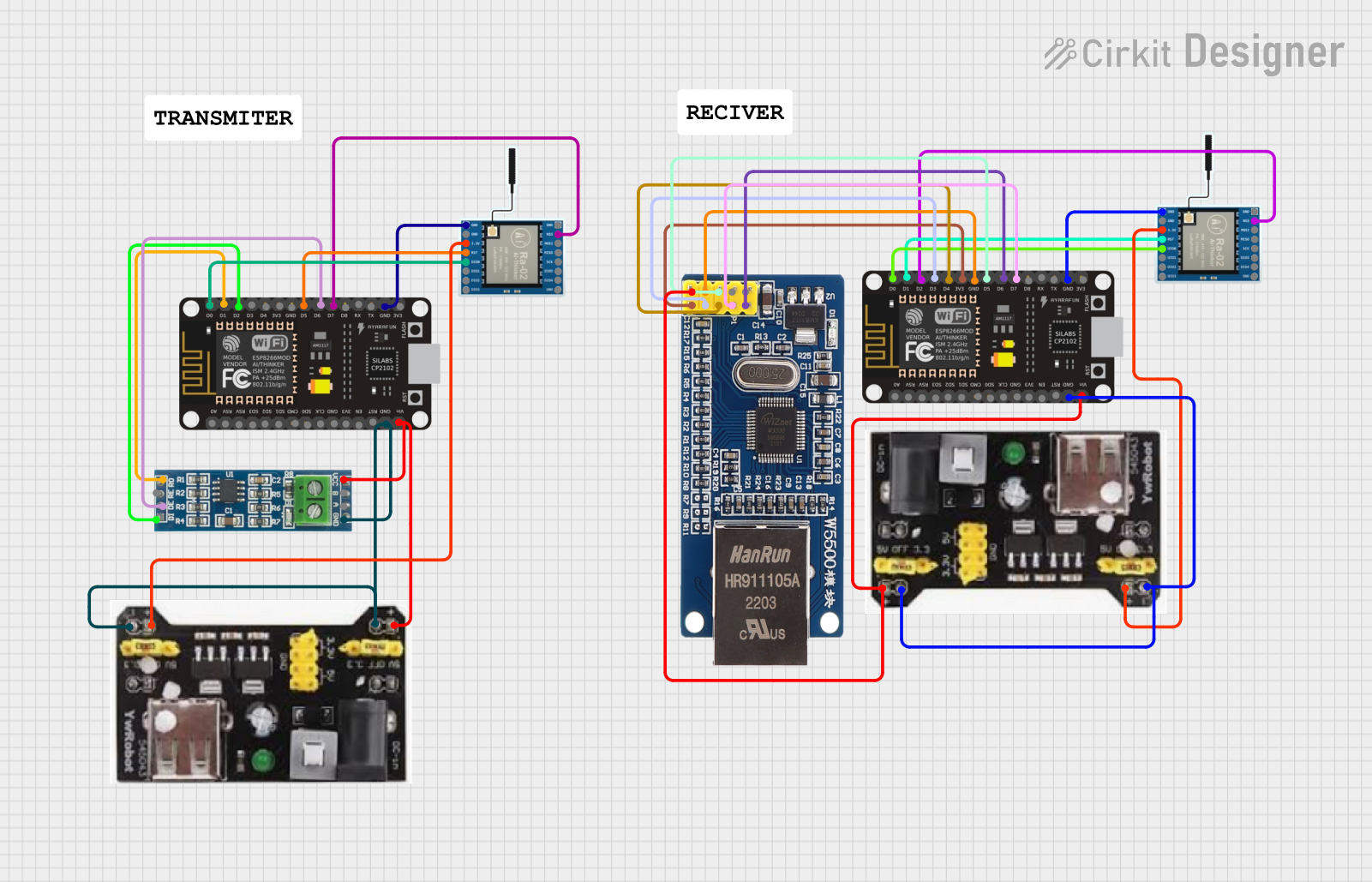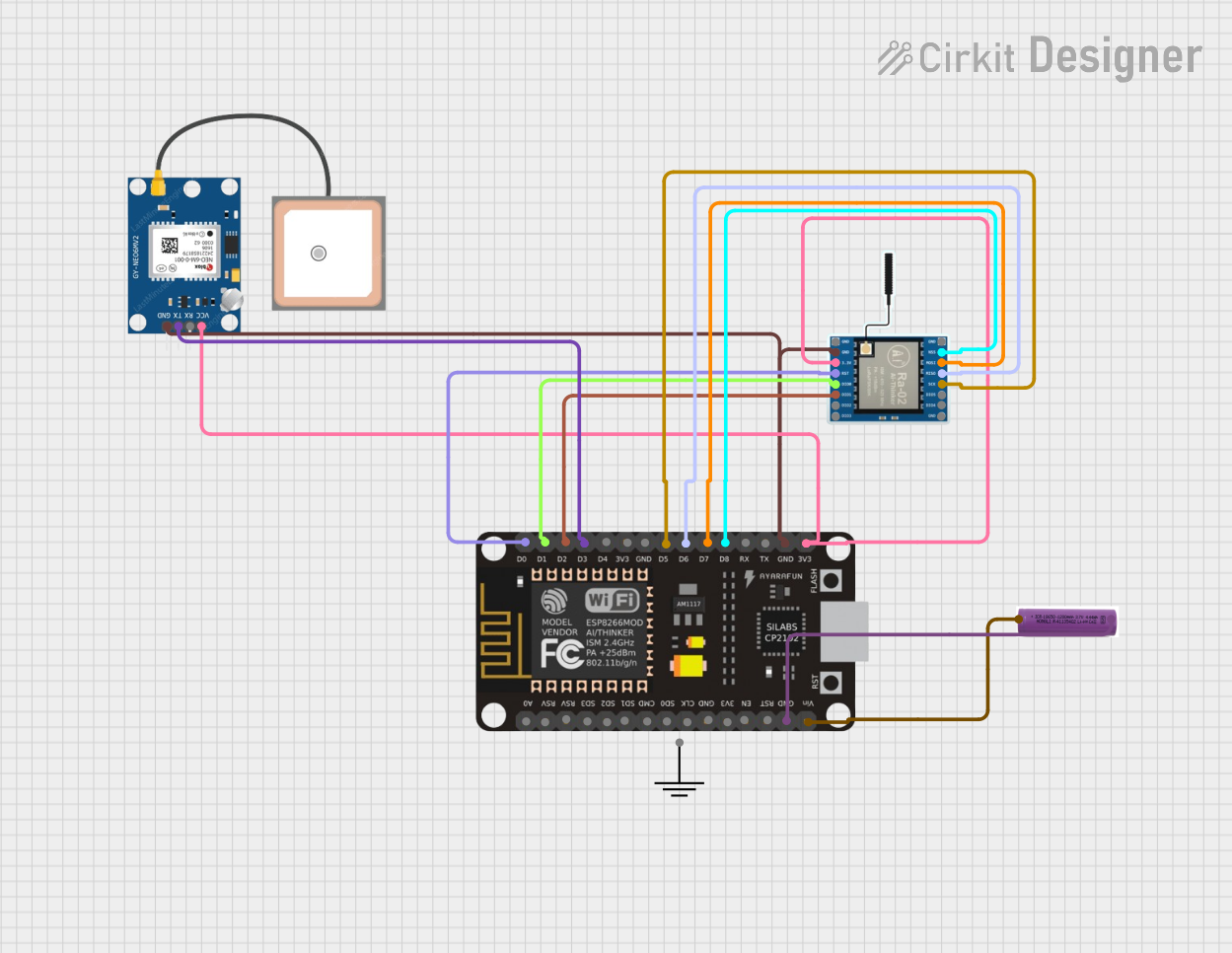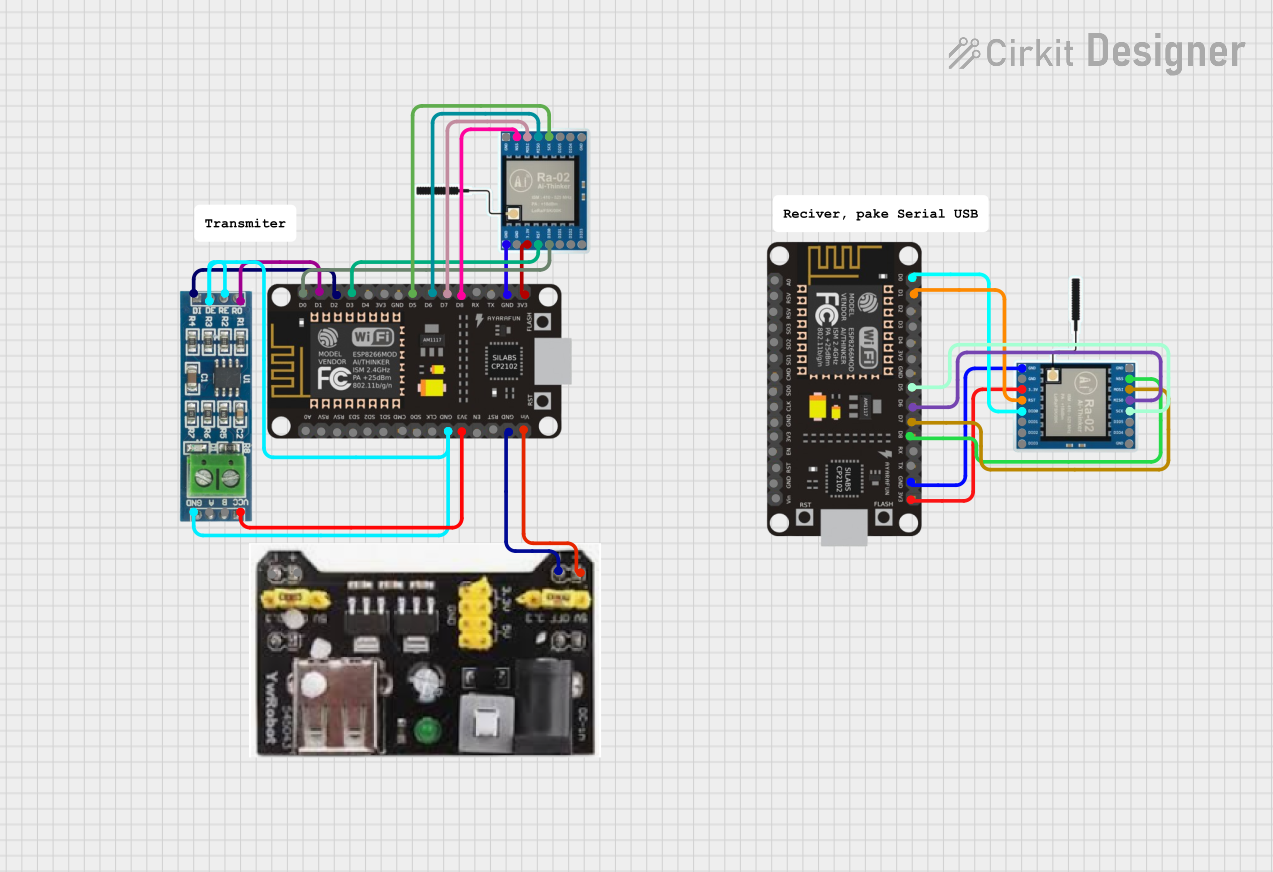
How to Use RP2040-Lora: Examples, Pinouts, and Specs

 Design with RP2040-Lora in Cirkit Designer
Design with RP2040-Lora in Cirkit DesignerIntroduction
The RP2040-Lora is a microcontroller board developed by Waveshare (Part ID: RP2040-SX1262). It integrates the powerful Raspberry Pi RP2040 microcontroller with the SX1262 LoRa module, enabling long-range, low-power wireless communication. This combination makes it ideal for Internet of Things (IoT) applications, remote sensing, and other projects requiring reliable, long-distance data transmission.
Explore Projects Built with RP2040-Lora

 Open Project in Cirkit Designer
Open Project in Cirkit Designer
 Open Project in Cirkit Designer
Open Project in Cirkit Designer
 Open Project in Cirkit Designer
Open Project in Cirkit Designer
 Open Project in Cirkit Designer
Open Project in Cirkit DesignerExplore Projects Built with RP2040-Lora

 Open Project in Cirkit Designer
Open Project in Cirkit Designer
 Open Project in Cirkit Designer
Open Project in Cirkit Designer
 Open Project in Cirkit Designer
Open Project in Cirkit Designer
 Open Project in Cirkit Designer
Open Project in Cirkit DesignerCommon Applications and Use Cases
- IoT networks for smart cities, agriculture, and industrial automation
- Environmental monitoring and remote sensing
- Low-power wireless communication in rural or remote areas
- LoRaWAN-based applications
- Wireless data logging and telemetry
Technical Specifications
Key Technical Details
| Parameter | Specification |
|---|---|
| Microcontroller | Raspberry Pi RP2040 |
| LoRa Module | SX1262 |
| Operating Voltage | 3.3V |
| Input Voltage Range | 5V (via USB-C) |
| Flash Memory | 2MB QSPI Flash |
| SRAM | 264KB |
| LoRa Frequency Bands | 868MHz (EU) / 915MHz (US) |
| Communication Interfaces | SPI, I2C, UART, GPIO |
| Power Consumption | Ultra-low power (depends on LoRa transmission) |
| Dimensions | 51mm x 21mm |
| Operating Temperature | -40°C to +85°C |
Pin Configuration and Descriptions
The RP2040-Lora features a 20-pin header for GPIO and communication interfaces. Below is the pinout:
| Pin Number | Pin Name | Description |
|---|---|---|
| 1 | 3V3 | 3.3V Power Output |
| 2 | GND | Ground |
| 3 | GP0 | General Purpose I/O (GPIO) |
| 4 | GP1 | General Purpose I/O (GPIO) |
| 5 | GP2 | General Purpose I/O (GPIO) |
| 6 | GP3 | General Purpose I/O (GPIO) |
| 7 | GP4 | General Purpose I/O (GPIO) |
| 8 | GP5 | General Purpose I/O (GPIO) |
| 9 | GP6 | General Purpose I/O (GPIO) |
| 10 | GP7 | General Purpose I/O (GPIO) |
| 11 | GP8 | General Purpose I/O (GPIO) |
| 12 | GP9 | General Purpose I/O (GPIO) |
| 13 | GP10 | General Purpose I/O (GPIO) |
| 14 | GP11 | General Purpose I/O (GPIO) |
| 15 | GP12 | General Purpose I/O (GPIO) |
| 16 | GP13 | General Purpose I/O (GPIO) |
| 17 | GP14 | General Purpose I/O (GPIO) |
| 18 | GP15 | General Purpose I/O (GPIO) |
| 19 | GP16 | General Purpose I/O (GPIO) |
| 20 | GP17 | General Purpose I/O (GPIO) |
Usage Instructions
How to Use the Component in a Circuit
Powering the Board:
- Connect the RP2040-Lora to a 5V USB-C power source. The onboard voltage regulator will provide the required 3.3V to the microcontroller and LoRa module.
Connecting Peripherals:
- Use the GPIO pins to connect sensors, actuators, or other peripherals. Ensure that all connected devices operate at 3.3V logic levels to avoid damage.
Programming the Board:
- The RP2040-Lora can be programmed using the C/C++ SDK or MicroPython. Connect the board to your computer via USB-C and upload your code using a compatible IDE (e.g., Thonny for MicroPython or Visual Studio Code for C/C++).
LoRa Communication:
- Use the SPI interface to communicate with the SX1262 LoRa module. Libraries such as the Arduino LoRa library or custom drivers can simplify the process.
Important Considerations and Best Practices
- Voltage Levels: Ensure all connected devices operate at 3.3V logic levels. Use level shifters if interfacing with 5V devices.
- Antenna Connection: Attach a suitable LoRa antenna to the SMA connector for optimal performance.
- Frequency Band: Configure the LoRa module to operate within the allowed frequency band for your region (e.g., 868MHz for Europe, 915MHz for the US).
- Power Consumption: Use sleep modes and optimize transmission intervals to minimize power consumption in battery-powered applications.
Example Code for Arduino UNO
Below is an example of how to use the RP2040-Lora with an Arduino UNO to send a LoRa message:
#include <SPI.h>
#include <LoRa.h>
// Define LoRa module pins
#define LORA_SCK 5 // SPI Clock
#define LORA_MISO 19 // SPI MISO
#define LORA_MOSI 27 // SPI MOSI
#define LORA_CS 18 // Chip Select
#define LORA_RST 14 // Reset
#define LORA_IRQ 26 // IRQ Pin
void setup() {
// Initialize serial communication
Serial.begin(9600);
while (!Serial);
// Initialize LoRa module
Serial.println("Initializing LoRa...");
if (!LoRa.begin(915E6)) { // Set frequency to 915 MHz
Serial.println("LoRa initialization failed!");
while (1);
}
Serial.println("LoRa initialized successfully.");
}
void loop() {
// Send a test message
Serial.println("Sending message...");
LoRa.beginPacket();
LoRa.print("Hello, LoRa!");
LoRa.endPacket();
// Wait for 5 seconds before sending the next message
delay(5000);
}
Notes:
- Replace the frequency
915E6with868E6if operating in Europe. - Ensure the LoRa module pins are correctly connected to the Arduino UNO.
Troubleshooting and FAQs
Common Issues and Solutions
LoRa Module Not Initializing:
- Ensure the SPI pins are correctly connected and configured in the code.
- Verify that the LoRa module is powered and the antenna is connected.
No Data Transmission:
- Check that both sender and receiver are configured to the same frequency and spreading factor.
- Ensure the devices are within range and there are no significant obstructions.
High Power Consumption:
- Use sleep modes for the RP2040 and SX1262 when not actively transmitting.
- Reduce the transmission frequency or data rate.
Programming Issues:
- Ensure the correct drivers for the RP2040 are installed on your computer.
- Use a compatible USB cable for data transfer (not just a charging cable).
FAQs
Q: Can I use the RP2040-Lora with LoRaWAN?
A: Yes, the SX1262 module supports LoRaWAN. You will need to implement a LoRaWAN stack or use a library that supports it.
Q: What is the maximum range of the RP2040-Lora?
A: The range depends on environmental factors, but it can reach up to 10 km in open areas with a clear line of sight.
Q: Can I power the board with a battery?
A: Yes, you can use a 3.7V LiPo battery with a suitable voltage regulator to provide 3.3V to the board.
Q: Is the RP2040-Lora compatible with MicroPython?
A: Yes, the RP2040 microcontroller supports MicroPython, and you can use it to program the board.